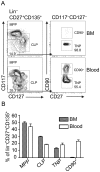Extra-thymic physiological T lineage progenitor activity is exclusively confined to cells expressing either CD127, CD90, or high levels of CD117
- PMID: 22355330
- PMCID: PMC3280270
- DOI: 10.1371/journal.pone.0030864
Extra-thymic physiological T lineage progenitor activity is exclusively confined to cells expressing either CD127, CD90, or high levels of CD117
Abstract
T cell development depends on continuous recruitment of progenitors from bone marrow (BM) to the thymus via peripheral blood. However, both phenotype and functional characteristics of physiological T cell precursors remain ill-defined. Here, we characterized a putative CD135(+)CD27(+) T cell progenitor population, which lacked expression of CD127, CD90, and high levels of CD117 and was therefore termed triple negative precursor (TNP). TNPs were present in both BM and blood and displayed robust T lineage potential, but virtually no myeloid or B lineage potential, in vitro. However, TNPs did not efficiently generate T lineage progeny after intravenous or intrathymic transfer, suggesting that a physiological thymic microenvironment does not optimally support T cell differentiation from TNPs. Thus, we propose that physiological T cell precursors are confined to populations expressing either CD127, CD90, or high levels of CD117 in addition to CD135 and CD27 and that TNPs may have other physiological functions.
Conflict of interest statement
Figures





Similar articles
-
Characterization of thymic progenitors in adult mouse bone marrow.J Immunol. 2003 Feb 15;170(4):1877-86. doi: 10.4049/jimmunol.170.4.1877. J Immunol. 2003. PMID: 12574354
-
ER-MP12 antigen, a new cell surface marker on mouse bone marrow cells with thymus-repopulating ability: II. Thymus-homing ability and phenotypic characterization of ER-MP12-positive bone marrow cells.Int Immunol. 1993 Sep;5(9):1099-107. doi: 10.1093/intimm/5.9.1099. Int Immunol. 1993. PMID: 8241054
-
Thymic anlage is colonized by progenitors restricted to T, NK, and dendritic cell lineages.J Immunol. 2005 Mar 1;174(5):2525-32. doi: 10.4049/jimmunol.174.5.2525. J Immunol. 2005. PMID: 15728458
-
Lineage choices in the developing thymus: choosing the T and NKT pathways.Curr Opin Immunol. 2004 Apr;16(2):167-73. doi: 10.1016/j.coi.2004.01.011. Curr Opin Immunol. 2004. PMID: 15023409 Review.
-
Commitment and developmental potential of extrathymic and intrathymic T cell precursors: plenty to choose from.Immunity. 2007 Jun;26(6):678-89. doi: 10.1016/j.immuni.2007.05.009. Immunity. 2007. PMID: 17582341 Review.
Cited by
-
Molecular evidence for a thymus-independent partial T cell development in a FOXN1-/- athymic human fetus.PLoS One. 2013 Dec 9;8(12):e81786. doi: 10.1371/journal.pone.0081786. eCollection 2013. PLoS One. 2013. PMID: 24349129 Free PMC article.
References
-
- Bhandoola A, von Boehmer H, Petrie HT, Zuniga-Pflucker J-C. Commitment and developmental potential of extrathymic and intrathymic T cell precursors: plenty to choose from. Immunity. 2007;26:678–689. - PubMed
-
- Perry SS, Wang H, Pierce LJ, Yang AM, Tsai S, et al. L-selectin defines a bone marrow analog to the thymic early T-lineage progenitor. Blood. 2004;103:2990–2996. - PubMed
-
- Igarashi H, Gregory SC, Yokota T, Sakaguchi N, Kincade PW. Transcription from the RAG1 locus marks the earliest lymphocyte progenitors in bone marrow. Immunity. 2002;17:117–130. - PubMed
Publication types
MeSH terms
Substances
LinkOut - more resources
Full Text Sources
Medical
Research Materials
Miscellaneous

